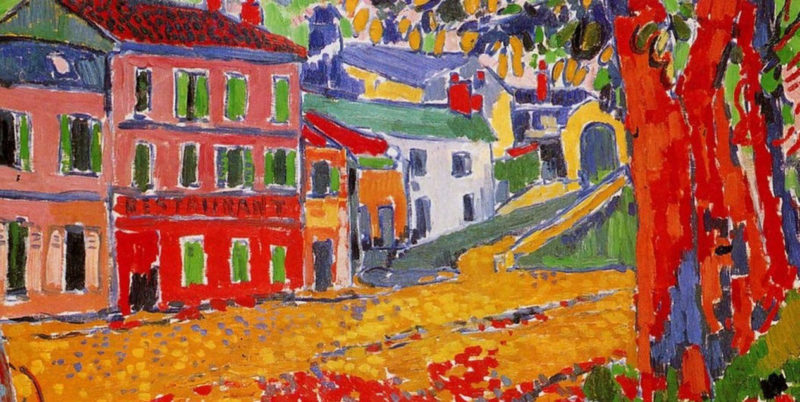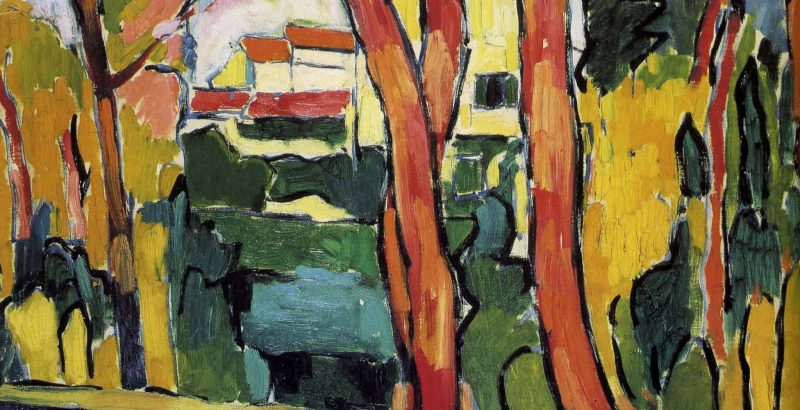We explain what Fauvism is and how this artistic movement originated. Also, what are its characteristics, influences and more.
What is Fauvism?
It is known as Fauvism or Fovism to a pictorial movement that emerged in France at the beginning of the 20th century and later spread to other countries, characterized by a provocative use of colors and fast, furious brushstrokes or, as they were baptized and from there the name would arise. of the movement, "ferocious".It was an avant-garde movement , which sought to go beyond what was achieved by traditional methods of expression in painting , which is why it often made use of techniques from neighboring plastic movements.
Among its main exponents , Henri Matisse, André Derain and Maurice de Vlaminck are usually mentioned , who would have "invented" it. The movement would disappear once these painters separated their paths and tendencies, but it would have a marked influence on the avant-garde and expressionism .
Origin of the name Fauvism
 It is assumed that the name of this movement would have arisen in 1905 , within the framework of the exhibition of some works by the main Fauvist authors in room VII of the Autumn Hall, where they would have generated an intense contrast with the others, which motivated to the critic Louis Vaxcelles to refer to them as les fauves , that is, "the beasts." With this he alluded to the "orgy of pure tones" that he had found in the paintings. The group of artists in question would then have taken over the term and thus the movement was born.
It is assumed that the name of this movement would have arisen in 1905 , within the framework of the exhibition of some works by the main Fauvist authors in room VII of the Autumn Hall, where they would have generated an intense contrast with the others, which motivated to the critic Louis Vaxcelles to refer to them as les fauves , that is, "the beasts." With this he alluded to the "orgy of pure tones" that he had found in the paintings. The group of artists in question would then have taken over the term and thus the movement was born.
Historical context of Fauvism
Fauvism arises in the Paris of the avant-gardes, in a true artistic and scientific explosion , which among many other things involved the reform and re-planning of the city by Georges-Eugène, the introduction of electricity and the automobile, the great Universal Exhibitions in that celebrated the ingenuity of the human being and prestigious exhibitions of plastic arts opposed to positivism, naturalism and impressionism , as was also the case of German expressionism.
Fierceness and simplicity
 The Fauvist authors did not have a manifesto, nor a common schematic project, but they were brought together by the fast and thick, “fiery” line, and a predilection for relatively simple forms , not too elaborate, that did not compete with the importance and vitality they gave. to bright and pure colors, "as they come out of the tube" according to de Vlaminck.
The Fauvist authors did not have a manifesto, nor a common schematic project, but they were brought together by the fast and thick, “fiery” line, and a predilection for relatively simple forms , not too elaborate, that did not compete with the importance and vitality they gave. to bright and pure colors, "as they come out of the tube" according to de Vlaminck.
Color autonomy
Each of the Fauvists painted according to their subjectivity freed from morality, expressive methods or teaching methods (they valued self-learning, immediacy and intuition ), in an attempt to restore to painting a certain purity of method , which was identified with the color of pure and intense tones.In that sense, they did not mind incurring a certain deformation of reality , as long as they were faithful to the expressive principles of painting.
Influences of Fauvism
 Many of the Fauvist artists came from the studios of the masters Charles Lhuillier , Eugene Carriere and Gustave Moreau, thus representing an initial step in his pictorial training.
Many of the Fauvist artists came from the studios of the masters Charles Lhuillier , Eugene Carriere and Gustave Moreau, thus representing an initial step in his pictorial training.The work of Paul Cezanne was extremely influential in the Fauvists , to the point that the end of the movement is attributed to the revaluation of the art of this French painter from 1907.
Other necessary references for the formation of the movement were Paul Gauguin, Redon, Moreau . And, also, diverse forms of art from Africa and Oceania , product of the colonial acquisitions of the Europe of the time.
Importance of Fauvism
The influence of Fauvism in the avant-garde was wide and can be observed in various artistic forms of the time. His style was reproduced by artists from Belgium, Spain , Hungary, and other nations , who adapted the Fauvist postulates to their traditions.Some artistic groups influenced by Fauvism were: Der Blaue Reiter (Germany) , Montparnasse Group ( Chile ), Die Brücke ( Germany ) and Knave of Diamonds (Russia).
Main authors of Fauvism
The main authors of Fauvism were Henri Matisse, André Derain and Maurice de Vlaminck , who are named as its creators. But other French Fauvist artists were Albert Marquet, George Braque, Raoul Duffy, and Charles Camoin.
Most recognized works of Fauvism
 Some well-known works of the Fauvist painters are as follows:
Some well-known works of the Fauvist painters are as follows:
- Matisse. Vase of sunflowers (1989), Woman Reading (1894), Landscapes of Collioure (1905), The Music (1910), Gypsy (1905) or The green stripe (1905).
- Derain. The Sails Drying (1905), Charing Cross Bridge (1906), Boats on the Beach at Colibre (1905), The London Pool (1906) and The Lighthouse at Collioure (1905).
- Vlaminck. The circus (1906), The tugboat on the Seine, Chatou (1906), Blue vase with flowers (1906), Valmondois Landscape () or The red trees (1906).
Fauvism in other arts
Some plastic artists (not painters) subscribed to Fauvism, such as André Metthey, Ambroise Vollard, Rouault and some others; of them came the notion that Derain, Matisse and Vlaminck made incursions in the ceramics , pyrography, drawing or watercolor , and there arose interesting artistic works blend.Matisse also wrote the "Jazz Book" , where he wrote and drew, and accompanied with engravings and lithographs works by the poet Mallarmé or editions of Los amores de Ronsard .
End of fauvism
Fauvism had a short life , like most avant-garde movements, and French Fauvist cadres for the most part date from the early 1900s.Once the so-called "essential triangle" of Matisse, Derain, and Vlaminck broke away , the original movement soon faded.
The above content published at Collaborative Research Group is for informational and educational purposes only and has been developed by referring reliable sources and recommendations from technology experts. We do not have any contact with official entities nor do we intend to replace the information that they emit.
Luke is passionate about fostering student involvement and connection. He studied psychology for his major and likes learning about the past. Luke aims to specialize in artificial intelligence and cybersecurity. .
Leave a reply
Your email address will not be published. Required fields are marked *Recent post

Sport: What Is It, Types, Risks, Features, Characteristics and Examples
September 23, 2021

Dogs: Emergence, Features, Characteristics, Feeding and Breeds
September 24, 2021

Story: Definition, Elements, Structure, Features and Characteristics
September 24, 2021

Essay: Definition, Structure, Features, Characteristics, How to Do It
September 24, 2021
